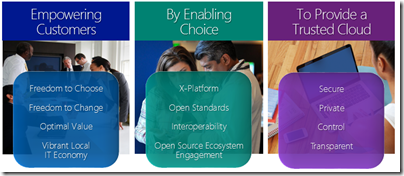Gjesteblogg: Microsoft has open approach to cloud
Written by: Pasi Mäkinen
This blog post is the first in a series of six blog posts highlighting various aspects of Microsoft’s open source strategy.
 As many customers and partners have already witnessed, Microsoft has been changing a lot in recent years. We are investing and innovating on cloud and building mobile experiences that help everyone to achieve more in their work and life. We have also changed our strategy towards Open Source.
As many customers and partners have already witnessed, Microsoft has been changing a lot in recent years. We are investing and innovating on cloud and building mobile experiences that help everyone to achieve more in their work and life. We have also changed our strategy towards Open Source.
Recent news on Satya Nadella declaring “Microsoft Loves Linux” or open sourcing of .NET framework are still the peak of the iceberg. Microsoft started the journey 10 years ago and has worked to enable customers to better run open source technologies like PHP and Node.js on Azure, to interoperate with other technologies like Linux, Samba and Moodle, and to contribute to open source projects like Hadoop and Linux Kernel.
Empowering customers
Our open approach is to help customers realize value of their open source investment in our trusted cloud.
The core concept in our approach is the empowerment of our customers. Instead of focusing on monetizing customer data or online retailing, customer empowerment is ingrained in Microsoft’s DNA. Taglines like the 1990’s ‘Making it Easier’ and later ‘Realize your Potential’ were both about empowering customers. In our open approach, empowerment means having the freedom to choose the technologies you want to use in cloud and freedom to change between cloud and on premise to optimize your value based on your mix of security, privacy, performance and cost variables.
Enabling customer choice
We are able to provide this choice because of our commitment to cross platform support to Windows, Linux and other device platforms like iOS and Android. You have probably seen how we have recently re-engineered some of our flagship products and services like Office, OneNote and OneDrive and made them readily available on iOS and Android.
Standards work
We also participate in over 150 standards bodies and 400 standards working groups to help in defining the open standards and to give us the opportunity to leverage those open standards so that our services can be accessed via open protocols and data formats from any operating system or programming language. For example the open data related OData standard by OASIS was originally developed by Microsoft and was proposed for standardization by Microsoft, IBM, SAP, Progress, CA, Red Hat and others.
I have first-hand experience of our standards effort via my engagement in ISO cloud computing standardisation. Incidentally, our big cloud competitors, the ad distributor and the online retailer are nowhere to be seen in the cloud standards process.
Fortunately these cloud standards are also exceptional at ISO as they are available free of charge: Cloud Vocabulary, Cloud Reference Architecture.
Community engagement
We also engage deeply with the global open source community and contribute to key open source projects. For example, the Azure engineering team has committed to engage, contribute and release open source code as part of our development process and has done so for the last 3 years, and we are key contributors to the Hadoop, Node.js and Linux projects.
About the writer: Pasi Mäkinen, Open Source Lead, Microsoft Western Europe, is working with customers and partners to drive open source based workloads on Microsoft Azure cloud platform. Contact at pasi.makinen@microsoft.com or follow at Twitter @pasimak. Check the rest of the Openness story at: microsoft.com/openness. Find fresh and upcoming webinars on Open Source and Azure here: https://info.microsoft.com/WE-OSSonAzure.html.
